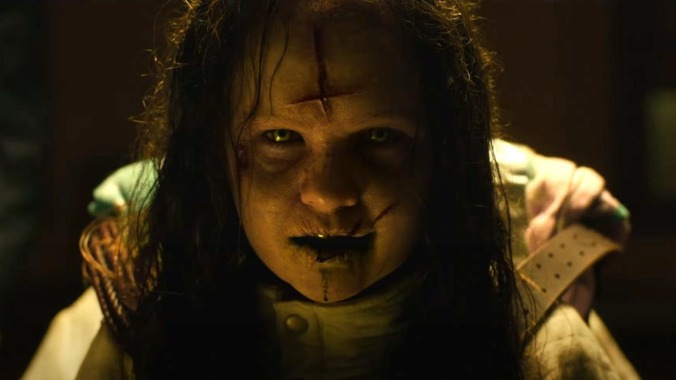The Exorcist: Believer review: What the devil is going on here?
Halloween director David Gordon Green’s latest franchise reboot is full of ideas—but they don’t add up to an actual movie

Legacyquels—sequels that come out decades after their original predecessor with the promise of recapturing its magic—are in no short supply these days, particularly in the horror genre. But how does one hop onto this trend with The Exorcist? The 1973 classic has never taken particularly well to franchising; it contributes more to the horror genre as the progenitor of imitators than as the first chapter in a serialized narrative. The Exorcist: Believer is an attempt by writer-director David Gordon Green and co-writer Peter Sattler to not only build upon the foundation of the original film, but to spark a new trilogy in the vein of Green’s recent Halloween revival. What a shame then that it’s never quite clear what they’re actually building toward.
Believer starts promisingly enough, with 13-year-old Angela (Lidya Jewett) and Katherine (Olivia O’Neill) wandering in the woods with the intent of ritualistically communing with Angela’s late mother, who died when Angela was born. The pair disappear for three days, only to reemerge with no memory of where they were and exhibiting increasingly disturbing behavior. Angela’s father Victor (Leslie Odom Jr.), a man who left faith behind with the death of his wife, is at a loss for how to deal with his daughter’s disappearance, erratic behavior, and self-mutilation, which of course turns out to be demonic possession.
This sums up approximately the first half of the film, which acts as a slow-burn character study that does a decent job of giving Victor a chance to explore his grief although virtually none of the other introduced characters are given any dimension or substance. Katherine’s evangelically religious parents (Jennifer Nettles and Norbert Leo Butz), their pastor (Raphael Sbarge), spiritualists Stuart (Danny McCarthy) and Dr. Beehibe (Okwui Okpoksawili), and Catholic Father Maddox (E.J. Bonilla) all hover at the periphery but none could be said to be a character beyond their dedication to their respective spiritualities. Even Katherine has next to no established character prior to her possession, and Angela is barely more than a prop for her father’s grief. The closest the film comes to a fleshed-out supporting character is Ann Dowd as a novitiate-turned-nurse whose backstory holds some unintentional comedy for how it implies God’s machinations, but it’s hard to credit the film for being entertaining by stumbling into absurdity.
In fact, Believer doesn’t seem to have any idea of what exactly God’s or the Devil’s machinations are supposed to be, what its story beats are meant to imply, or what its characters are supposed to glean from their encounter with the unholy. The film is a grab bag of half-baked ideas that never coalesce into a coherent theme or a reason to exist. What does Ellen Burstyn’s brief return as Chris MacNeil, mother of the possessed Regan in the original film, bring to the story? Almost nothing save confirmation that this is the same demon back again, which in turn only serves to justify the Exorcist branding. What do the film’s continual motifs gesturing toward motherhood signify, especially in relation to Victor’s struggles as a widowed father? Not a thing, it turns out, though a last-minute twist sure wants to pretend they do. Is there any meaning to be mined from a cross-section of religious disciplines banding together to exorcise the two girls? An interesting idea but squandered in a third act where the united faiths only take turns seeing which of their disparate methods can annoy the demons, never providing more than lip service to exploring what faith even means. Even the quirk of having two possessed girls is a promise left unfulfilled, seemingly acting as set-up for the proposed sequel without having any significance in the story currently being told.
This adds up to a film that is not only thematically hollow, but not even especially confident in its own scares. That slow-burning first act is constantly interrupted by the cheapest jump scares, and the actual exorcism plays like a bad improv sketch. It follows no rules of traditional exorcism stories and it doesn’t establish any new rules to supplant them, so any attempts to shock and subvert are buried in a malaise of obscured cause and effect. That’s not scary. It’s just nonsense.
The Exorcist: Believer doesn’t give us a reason to care about what we’re meant to experience, its titular crisis of faith vaguely gestured towards rather than adequately explored. What’s meant as an enticing cliffhanger is instead a limp denouement in which the characters have learned nothing, and we have learned nothing from them. An exorcism movie may not need to be compelled by the power of Christ, but something about it still needs to be compelling, and slapping the name The Exorcist on a screenplay that reads like a brainstorming session is just not enough.
The Exorcist: Believer opens in theaters on October 6